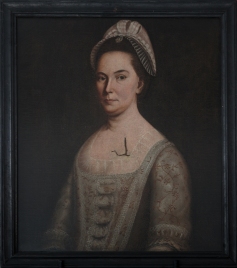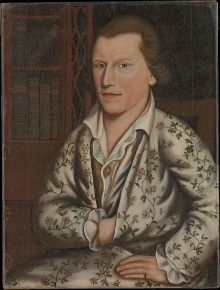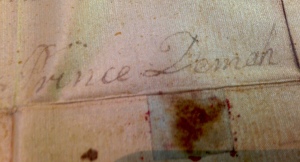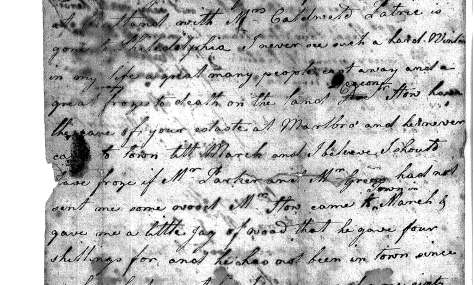On November 4, 1841, a young Frederick Douglass—only three years removed from slavery—gave one of his first recorded speeches at a meeting of the Plymouth County Anti-Slavery Society at the First Baptist Church here in Hingham. On August 10, 1841, only three months earlier, Douglass had appeared on Nantucket Island, at a meeting of the island’s Anti-Slavery Society, where he first met William Lloyd Garrison and launched a career as an abolitionist lecturer and activist.
 One item on the agenda at the Hingham meeting in November was a resolution to censure northern Protestant churches which practiced segregation. It was on this subject that Douglass spoke that day.
One item on the agenda at the Hingham meeting in November was a resolution to censure northern Protestant churches which practiced segregation. It was on this subject that Douglass spoke that day.
Frederick Douglass was not yet the legendary figure that he soon became in abolitionist circles—indeed, when he returned to Hingham three years later to speak at the Great Abolition Pic Nic held at Tranquility Grove, he was a “headliner” among the speakers. But in November 1841, he was a relative unknown and was introduced to the Society as follows, as reported by Hingham’s local paper, the Patriot, on November 11th:
A colored man then rose, and was introduced to the meeting by Rev. Mr. May, [the Society’s] President, as Mr. Douglass. It appears that he is a runaway slave, “about whom,” said Mr. May, “an interesting story might be told, but it is not expedient to make its details public.
Douglass later addressed the meeting at several points, including, again in the words of the Patriot, “allud[ing], with considerable wit, to the union between the churches of the North and the South . . . .” This appears to be a reference to the short oration that was recorded, titled The Church and Prejudice. It opened as follows:
At the South I was a member of the Methodist Church. When I came north, I thought one Sunday I would attend communion, at one of the churches of my denomination, in the town I was staying. The white people gathered round the altar, the blacks clustered by the door. After the good minister had served out the bread and wine to one portion of those near him, he said, “These may withdraw, and others come forward;” thus he proceeded till all the white members had been served. Then he took a long breath, and looking out towards the door, exclaimed, “Come up, colored friends, come up! for you know God is no respecter of persons!” I haven’t been there to see the sacraments taken since.
As he continued to speak of the Northern church (in New Bedford, where he had settled on coming north), the “wit” alluded to by the Patriot was on show. Describing the charismatic experiences of certain parishioners, he told this story:
Another young lady fell into a trance. When she awoke, she declared she had been to heaven. Her friends were all anxious to know what and whom she had seen there; so she told the whole story. But there was one good old lady whose curiosity went beyond that of all the others—and she inquired of the girl that had the vision, if she saw any black folks in heaven? After some hesitation, the reply was, “Oh! I didn’t go into the kitchen!”
The full text of the speech can be found here.

First Baptist Church, Hingham, Mass., c. 1885
The resolution concerning the stance of northern Protestant churches passed. Douglass himself made a deep impression on the correspondent for the Hingham Patriot, as can be seen in this passage of his extended report on the Anti-Slavery Society’s meeting:
. . . [A]s Douglass stood there in manly attitude, with erect form and glistening eye and deep-toned voice, telling us that he had been secretly devising means to effect his release from bondage, we could not help thinking of Spartacus the Gladiator . . . . A man of his shrewdness, and his power both intellectually and physically, must be poor stuff, thought we, to make a slave of. At any rate, we would not like to be his master. . . .
He is very fluent in the use of language, choice and appropriate language too; and talks as well, for all that we could see, as men who spent all their days over books. He is forcible, keen, and very sarcastic, and considering the poor advantage he must have had as a slave he is certainly a remarkable man.
The Hingham Patriot’s article can be found here.
A comment on the photograph at the top of this post. It is the earliest image of Douglass, taken in 1841, the year he first came to Hingham. Renee Graham wrote a wonderful piece on photographs of Douglass, including this image (from the collection of Greg French) for wbur.org. It can be found here. Her observation on this image:
. . . . Even in that first palm-sized photograph, Douglass seemed to fully understand the power of a single image. More than 150 years since it was taken, its ability to devastate has not been dulled.
Handsome and about 23, Douglass peers directly into the camera. His eyes blaze with fearless purpose and determination; he all but defies the viewer to look away. This, the photograph silently proclaims, is not a man to be trifled with. No mere runaway slave, Douglass is the face of freedom.










